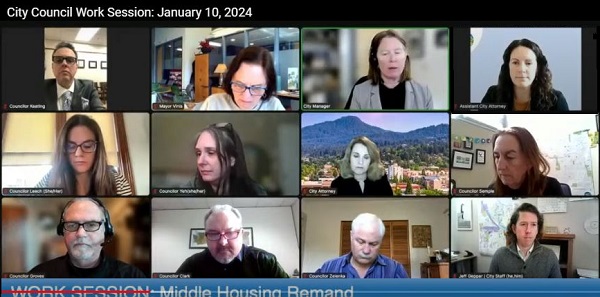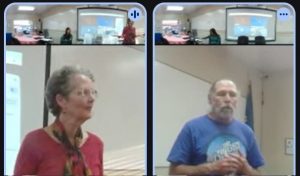Councilors share frustration as city hurries to fix middle housing code
7 min read
The city council is still working on middle housing, after a court said the city fell short of showing that its water, sewer, and transportation services plan addressed higher density, at the time the middle housing ordinance was adopted. On Jan. 10:
Lauren Sommers (Assistant City Attorney): Lauren Sommers, Assistant City Attorney, and I’m going to talk just in a little more detail about the appeal…
[00:00:22] Land use code amendments and Metro Plan amendments, which are included in the middle housing ordinance, have to be consistent with statewide land use planning goals. And Goal 11 requires cities to adopt a public facility plan that describes the water, sewer and transportation facilities that support the land uses… within the city’s urban growth boundary.
[00:00:48] The Court of Appeals determined that the city…didn’t do enough to show consideration of the relationship between the density that might result and the existing public facilities and services plan.
[00:01:04] John Q: Two city councilors expressed frustration.
[00:01:10] Councilor Mike Clark: Staff may remember part of my disagreement with this process originally in ‘22—and I think my ‘No’ vote was around the Goal 11, it was around everything we were discussing with this: It gives me heartburn knowing that…we are not going to be building homes anywhere near fast enough to serve the community and the demand that we’re having—which has an impact on pricing and affordability.
[00:01:37] I think we’re dramatically underbuilt and I think anyone in this business can say that that’s the case. My concern is sufficient findings under Goal 11 and the manner in which we do it… If we’re telling somebody they must do infill, it’s our job to make sure that the system we have in place and the plan that we have for updating it is sufficient (to handle) the amount of new housing.
[00:02:06] Councilor Randy Groves: The point I want to make is, once again, raising my frustration with the state thrusting this upon us. I still consider it an overreach and more than just an encroachment. It’s a big step over the line into home rule. And that still concerns me. And as we move forward, and if this continues, it’s going to be more concerning.
[00:02:28] I understand why we took the model code and tried to make it fit within our existing city code, but I still think the model code would have been a more streamlined way to move forward. Here we are: We’re now having more delays. I don’t like it when people that are trying to produce housing get frustrated and confusion and delaying in what we need.
[00:02:51] And so I want to tack on to what Councilor Clark said… and I will add not just housing, but also, business and industry that helps support our economy.
[00:03:02] Councilor (Greg) Evans and I have been working in West Eugene and we’ve had, some solar manufacturers have been very interested in locating here and there’s no land for them to set up on. I mean, they need 100-acre parcels and we just don’t have any of that.
[00:03:16] And then I, in comparison to Salem, and I’ve done a little bit of my own research on this, a city roughly our same size, they have 10 more square miles in their urban growth boundary than Eugene does. And that is at the root of a lot of the problems we have.
[00:03:33] I’m all for infill, but I think we’re cutting ourselves short and being very short-sighted if we don’t look past just what infill will produce and also have developable lands, and again, with maybe new types of neighborhoods. I’m not suggesting everything be single-occupancy detached dwellings, because I realize that’s not the model that fits with where we’re trying to go as a community.
[00:03:57] But at the same time, our lands, our available lands are so constrained and so much of what is available is in the hills, which is not affordable to build on. So I realize this is separate from this conversation, but I really think we need to come back and revisit that.
[00:04:15] John Q: The court decision has left developers confused.
[00:04:19] Jeff Gepper (Planning): Jeff Gepper, Senior Planner. So on Oct. 12, when we got the remand from the Land Use Board of Appeals, we can no longer apply our locally-adopted ordinance. What we had to apply at that point was middle housing state model code and the middle housing statutes and middle housing land divisions…
[00:04:37] So, middle housing development is not stopped. It’s still going, it’s still being permitted, but they have to meet these state rules. And the impacts of that are really one, and first and foremost, it’s just general confusion about what codes people are trying to meet in Eugene. Whether it’s Mom and Pop or a developer, whoever, they just are like, ‘Wait a minute, do I need to address Eugene’s code, the state code, what am I doing here?’…
[00:05:02] They actually don’t have the certainty anymore that they can actually build what they wanted to. So they’re faced with this, like, waiting period where they’re waiting to submit applications until Eugene’s middle housing ordinance is either back in place, or having to redesign their project to essentially meet the model code.
[00:05:18] John Q: The city thinks it has a proposed fix, and will hold a public hearing as soon as possible.
[00:05:26] Lauren Sommers (Assistant City Attorney): The court said there are a couple ways that the city could show compliance with Goal 11. One would be to update the public facility plan at about the same time as you adopt this new ordinance so that you can show very clearly that the city has sufficient public facilities to serve these new uses.
[00:05:45] But the court acknowledged that’s a big undertaking and that it probably wasn’t feasible in the amount of time that the legislature gave the cities…
[00:05:56] So the court also said another option for complying with (Goal) 11 is to adopt provisions similar to those in the model code that, quote, ‘limit or prohibit middle housing on lots that lack sufficient infrastructure.’
[00:06:11] So if the middle housing can’t be served, then the middle housing can’t be built.
[00:06:16] So if an applicant comes in and asks for a building permit and cannot show that there’s water to the property or sewer service to the property, then we won’t issue the building permit.
[00:06:26] So, staff is proposing additional findings for council to adopt…
[00:06:32] There are some new additions to the overview, …there are a few additions to the findings related to Goal 1 (because there will be additional process associated with the remand that we want to note), but the bulk of the, the substance of the new findings is under compliance with Goal 11.
[00:06:50] And the new proposed findings… adopt the Public Works analysis that was done prior to adoption of the original ordinance, that found that the city does have sufficient infrastructure capacity to serve any increased density that will be created by these middle housing developments.
[00:07:15] Councilor Alan Zelenka: So how would a developer know if there is sufficient public facilities and services available to proceed? Our system for hooking up to public facilities and services is a first-come, first-serve basis. So how can they plan if they don’t know what the amount of capacity available is?
[00:07:35] Jeff Gepper (Planning): If there’s an area that has low capacity or known capacity issue, a flag goes up on that, and they’re informed at that time. Most people don’t just submit out of the blue like that, though. They normally are in communication with the Public Works team. If we’re talking about a larger development, most people come in to us through a project consultation, where we walk through all those potential issues that might arise, including access to infrastructure along the same line. So there’s a lot of different avenues where you can get that info.
[00:08:02] Councilor Alan Zelenka: And if the development is going to occur in a place that has a constraint or lack of public facilities and services, how do they proceed? I know that you can expand the system or add, like, electricity lines or sewer lines or water lines if it’s not there, but then the developer has to make provisions to get them there and pay for it as part of the development.
[00:08:28] Jeff Gepper (Planning): Yeah, the land use code has a provision in 9.6505, which grants us the authority to require them to make those improvements. That’s correct.
[00:08:35] John Q: The city gambled on an ambitious approach to the state’s HB 2001 middle housing mandate, and lost in court. Now developers are confused, and desperately-needed housing is delayed. The city thinks it has a fix and will ask for public comment. To get involved, see the city’s page on middle housing.



